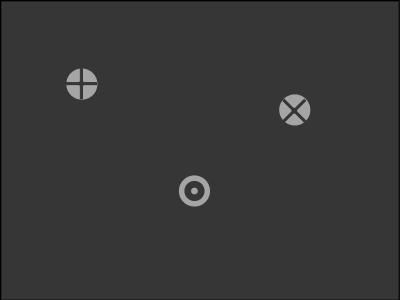I've consolidated and re-posted here most of the material I posted yesterday in the thread that was destroyed by the "backup" problem....
My personal conclusions from all of this information and from personal experience is that a dark background theme is not necessarily a bad choice for a website which is predominantly displaying screenshots of scenes from Celestia (which tend to be predominantly dark of course).
However, I believe that when the main activity is reading and posting text and discussion, rather than viewing images (ie. a forum), then a dark-text on light-background (lowered-contrast) theme makes for easier reading and is less tiring in the long run. Regardless of whether it's dark-on-light or light-on-dark however, I do think that reducing the contrast between text and background (within reason) makes for better readability and less eye-strain.
I do think it's a good idea to NOT have the glare of a bright white background, however I don't think that a "high-contrast" white-on-black theme is the best solution, because "high-contrast" brings it's own set of issues (in terms of loss of focus causing text-legibility issues). This is actually quite analogous to some of the issues seen with photographic lenses at their extreme limits (after all, the eye is also a lense, and the same rules of physics/optics apply).
Most of my personal conclusions do seem to be backed up by the experiences and research presented in the following links.
1. This page:
https://www.quora.com/Are-dark-themes-for-IDEs-and-code-editors-good-for-the-eyes presents the merits of high-contrast versus reduced-contrast themes:

- lowcontrast.png (1.19 KiB) Viewed 72941 times
2. A reddit thread with various opinions about contrast, readability, etc is here:
https://www.reddit.com/r/programming/comments/4nrsw1/is_dark_theme_in_ides_actually_worse_for_you/3. This thread summarizes research about "light-on-dark" versus "dark-on-light" themes:
https://ux.stackexchange.com/questions/53264/dark-or-white-color-theme-is-better-for-the-eyes and concludes:
There has been a lot of research on this topic since the 1980s and a lot of it still holds true today. One study from the 1980s states this:
However, most studies have shown that dark characters on a light background are superior to light characters on a dark background (when the refresh rate is fairly high). For example, Bauer and Cavonius (1980) found that participants were 26% more accurate in reading text when they read it with dark characters on a light background.
Reference: Bauer, D., & Cavonius, C., R. (1980). Improving the legibility of visual display units through contrast reversal. In E. Grandjean, E. Vigliani (Eds.), Ergonomic Aspects of Visual Display Terminals (pp. 137-142). London: Taylor & Francis
The reason why this matters is because of focus. As this article on UXMovement states, "white stimulates all three types of color sensitive visual receptors in the human eye in nearly equal amounts." It causes the eye to focus by tightening the iris. Since the eye is focused, dark letter forms on light backgrounds are easier to read. When using a dark background with strong light letter forms, the iris opens to allow more light in, but that causes letter forms to blur. Why?
People with astigmatism (approximately 50% of the population) find it harder to read white text on black than black text on white. Part of this has to do with light levels: with a bright display (white background) the iris closes a bit more, decreasing the effect of the "deformed" lens; with a dark display (black background) the iris opens to receive more light and the deformation of the lens creates a much fuzzier focus at the eye.
Jason Harrison – Post Doctoral Fellow, Imager Lab Manager – Sensory Perception and Interaction Research Group, University of British Columbia
Now there seem to be varying factors into contrast and legibility. Room ambient lighting. Brightness of the monitor. Also you can mitigate the straining effects of white (#FFF) on black (#000) by simply lessening the contrast like using a light gray (#EEE, #DDD, #CCC) on a dark background (#111, #222).
4. Finally, here again are the comparison screenshots I posted of this thread in it's 2 current themes ... ideally you should open each of these screenshots in it's own tab so that you can view each in isolation from the others (R-mouse->"Open link in new Tab"):
... plus a very rough lowered-contrast hack of the hexagon theme:
... and just for balance, the reverse approach ... a lowered-contrast "dark-on-light" version of hexagon:
Personally, I find something like the last one (a lowered contrast dark-on-light theme) is more legible and readable than the other three.
CC





















